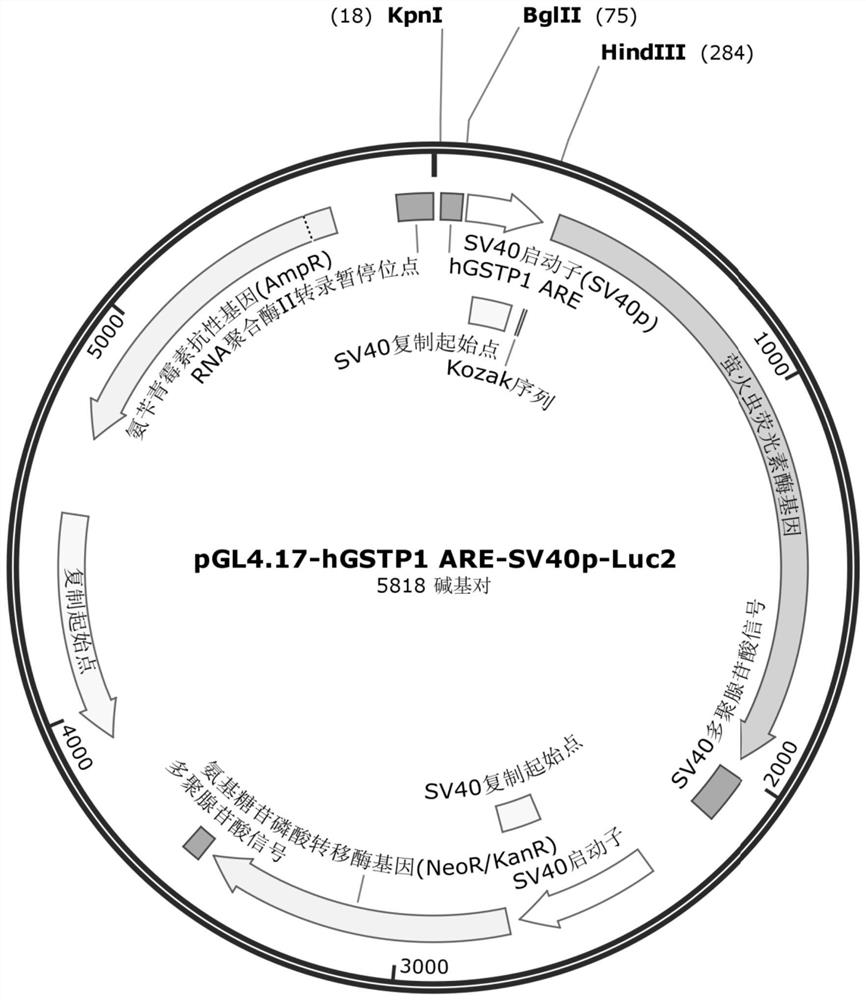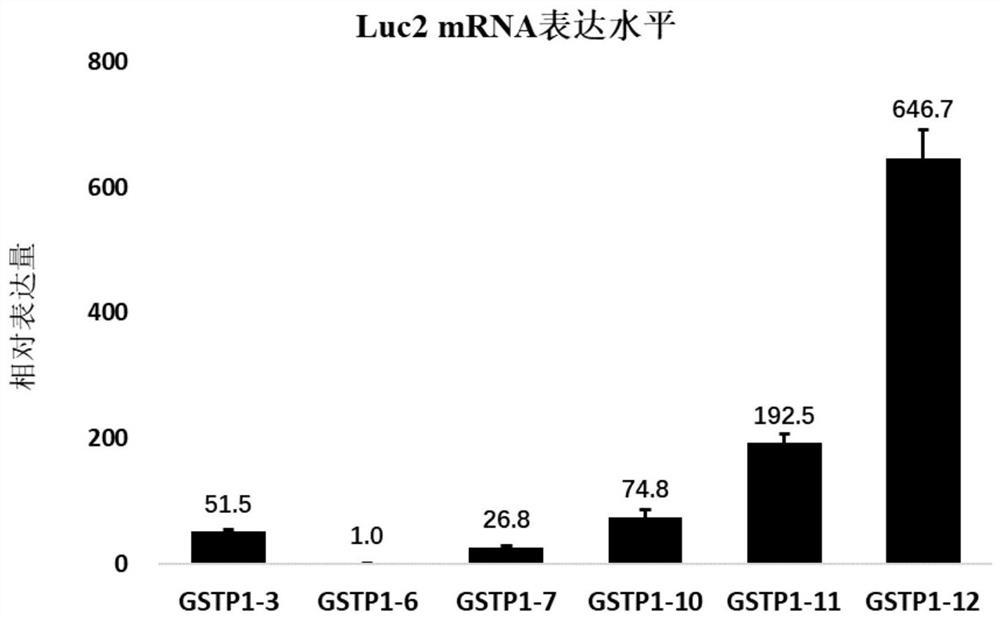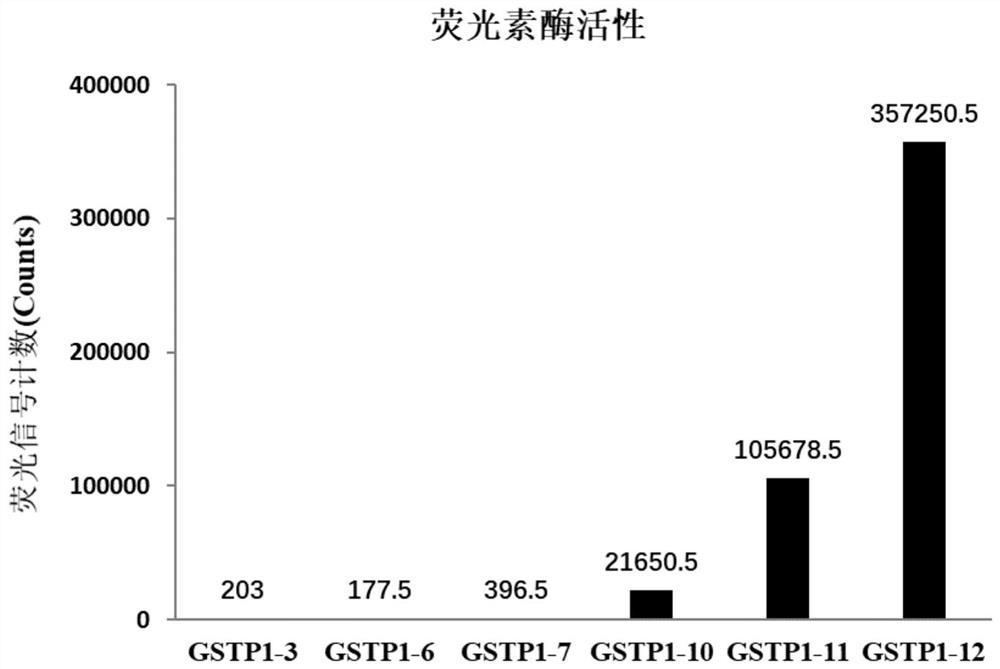Construction of cell strain containing luciferase reporter gene of human GSTP1 ARE and application thereof
A technology of luciferase and reporter gene, applied to genetically modified cells, cells modified by introducing foreign genetic material, applications, etc., can solve problems such as differences
- Summary
- Abstract
- Description
- Claims
- Application Information
AI Technical Summary
Problems solved by technology
Method used
Image
Examples
Embodiment 1
[0043] Example 1: Vector construction, cell line construction and single cell clone purification and identification
[0044] 1. Experimental principle
[0045] The required DNA fragment was synthesized by the whole gene synthesis method and inserted into the reporter vector pGL4.17[luc2 / Neo] to obtain the overexpression vector pGL4.17-hGSTP1 ARE-SV40p-Luc2; it was introduced into HaCaT cells by electroporation, and Neomycin screening was performed to obtain stable overexpression cell lines, single cell clones were selected, and RT-qPCR method was used to detect the overexpression of Luc2 mRNA in the cell clones.
[0046] 2. Experimental method
[0047] 1. Construction of luciferase reporter gene vector pGL4.17-hGSTP1 ARE-SV40p-Luc2
[0048] DNA fragment 1 (SEQ ID NO: 1) was synthesized by the whole gene synthesis method, the sequence from the 5' end to the 3' end is the restriction endonuclease KpnI restriction site GGTACC, the human GSTP1 gene promoter region ARE element, ...
Embodiment 2
[0065] Example 2: Detection of known extremely strong skin sensitizer 2,4-dinitrochlorobenzene by KeraSens cell line 1. Experimental principle
[0066] The Keap1-Nrf2-ARE pathway is the main regulatory pathway of cytoprotective responses to electrophilic and oxidative stress, which can regulate the expression of detoxification, antioxidant and stress response enzymes and proteins. This pathway is involved in the process of skin allergy and can be induced by skin Sensitive substances are activated. Glutathione S-transferase 1 (glutathione S-transferase P1, GSTP1) is a member of the glutathione sulfhydryl transferase (GSTs) family, which catalyzes the interaction of many hydrophobic and electrophilic compounds with reducing gluten Glutathione binding plays an important role in the detoxification process. The GSTP1 gene contains ARE elements, which are regulated by the Keap1-Nrf2-ARE pathway. The KeraSens cell line is a genetically engineered epidermal keratinocyte cell line, w...
Embodiment 3
[0137] Example 3: Detection of known strong skin sensitizer bromothalonil by KeraSens cell line
[0138] 1. Experimental principle
[0139] The Keap1-Nrf2-ARE pathway is the main regulatory pathway of cytoprotective responses to electrophilic and oxidative stress, which can regulate the expression of detoxification, antioxidant and stress response enzymes and proteins. This pathway is involved in the process of skin allergy and can be induced by skin Sensitive substances are activated. Glutathione S-transferase 1 (glutathione S-transferase P1, GSTP1) is a member of the glutathione sulfhydryl transferase (GSTs) family, which catalyzes the interaction of many hydrophobic and electrophilic compounds with reducing gluten Glutathione binding plays an important role in the detoxification process. The GSTP1 gene contains ARE elements, which are regulated by the Keap1-Nrf2-ARE pathway. The KeraSens cell line is a genetically engineered epidermal keratinocyte cell line, which contai...
PUM
 Login to View More
Login to View More Abstract
Description
Claims
Application Information
 Login to View More
Login to View More - R&D
- Intellectual Property
- Life Sciences
- Materials
- Tech Scout
- Unparalleled Data Quality
- Higher Quality Content
- 60% Fewer Hallucinations
Browse by: Latest US Patents, China's latest patents, Technical Efficacy Thesaurus, Application Domain, Technology Topic, Popular Technical Reports.
© 2025 PatSnap. All rights reserved.Legal|Privacy policy|Modern Slavery Act Transparency Statement|Sitemap|About US| Contact US: help@patsnap.com



